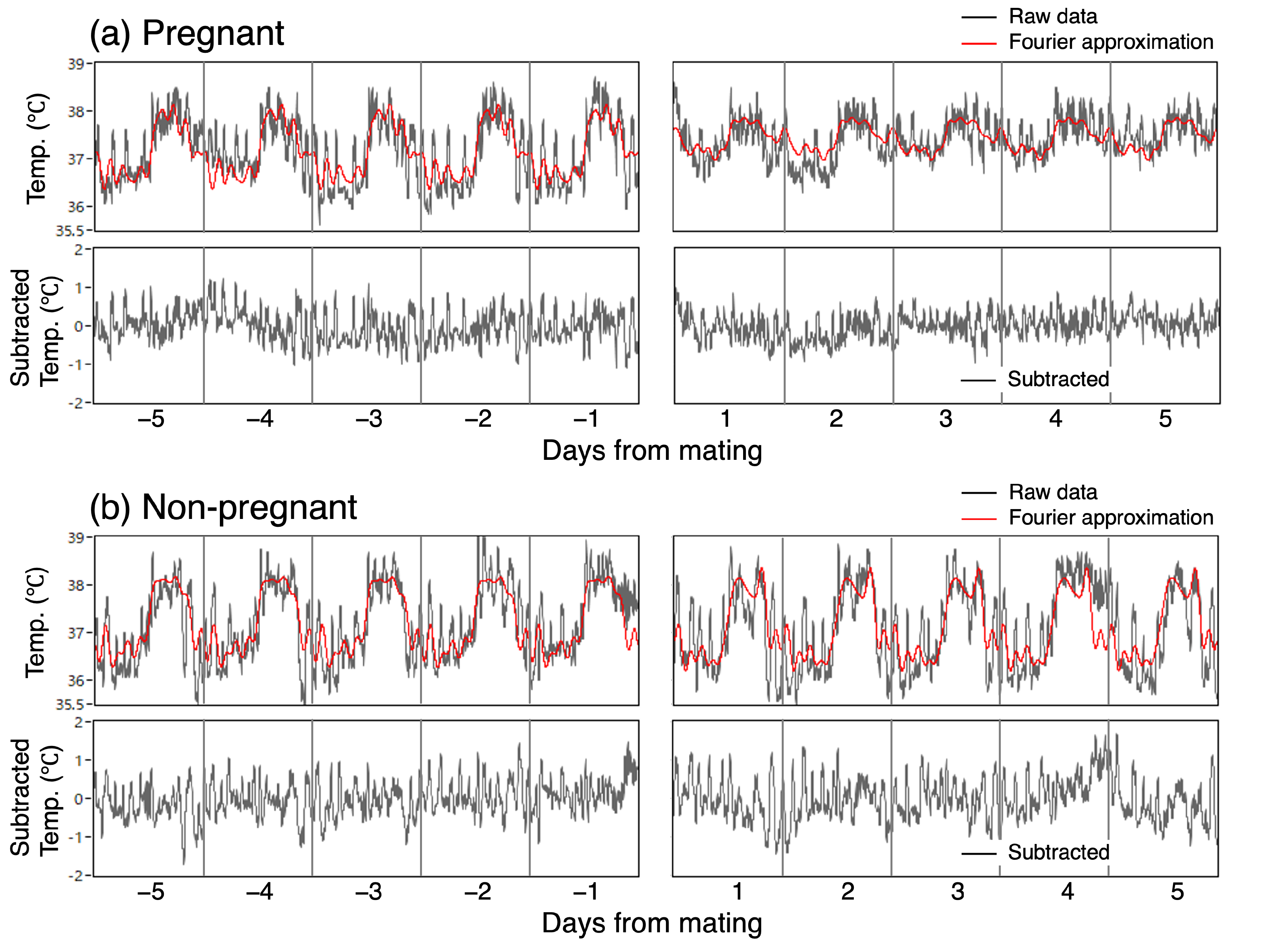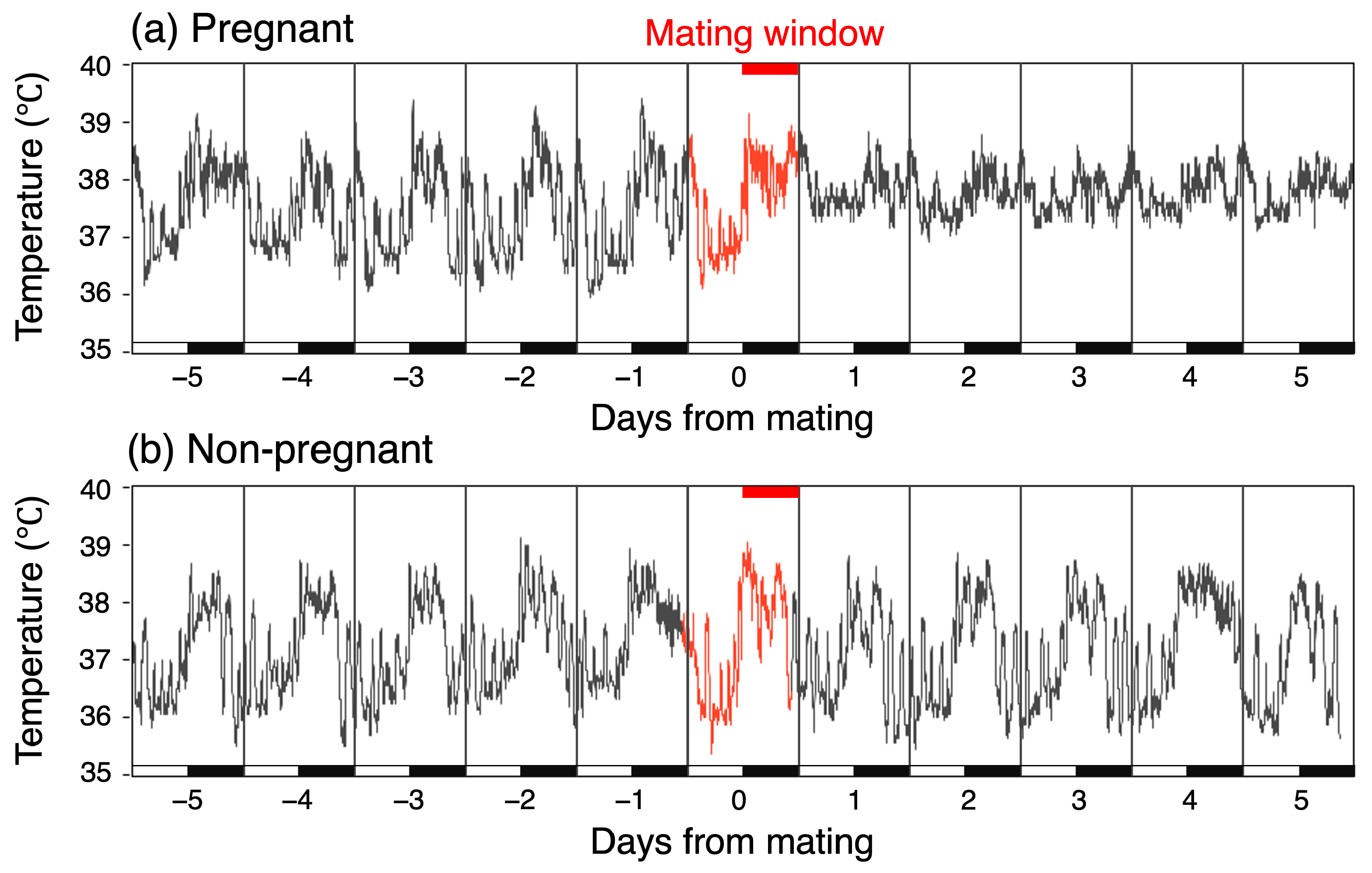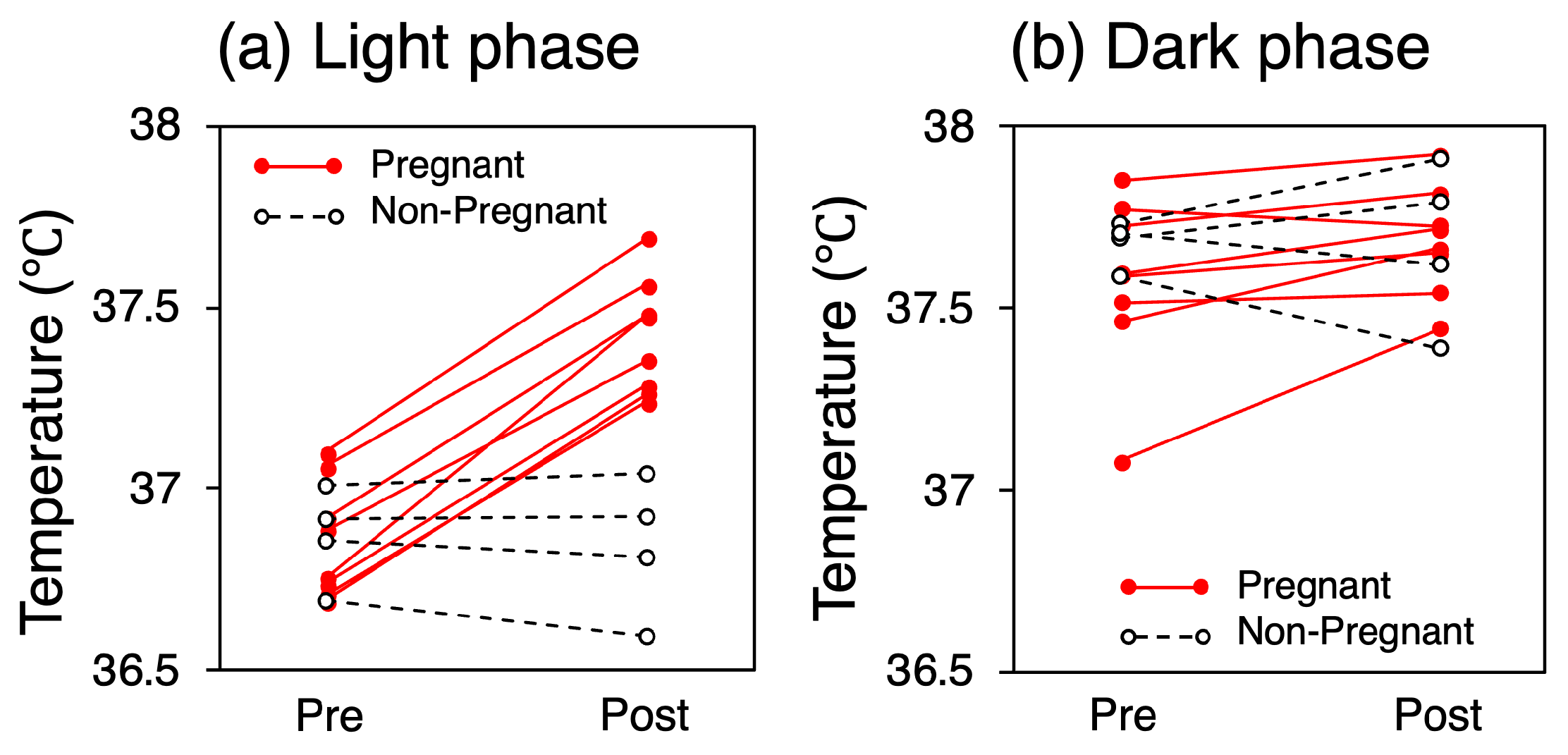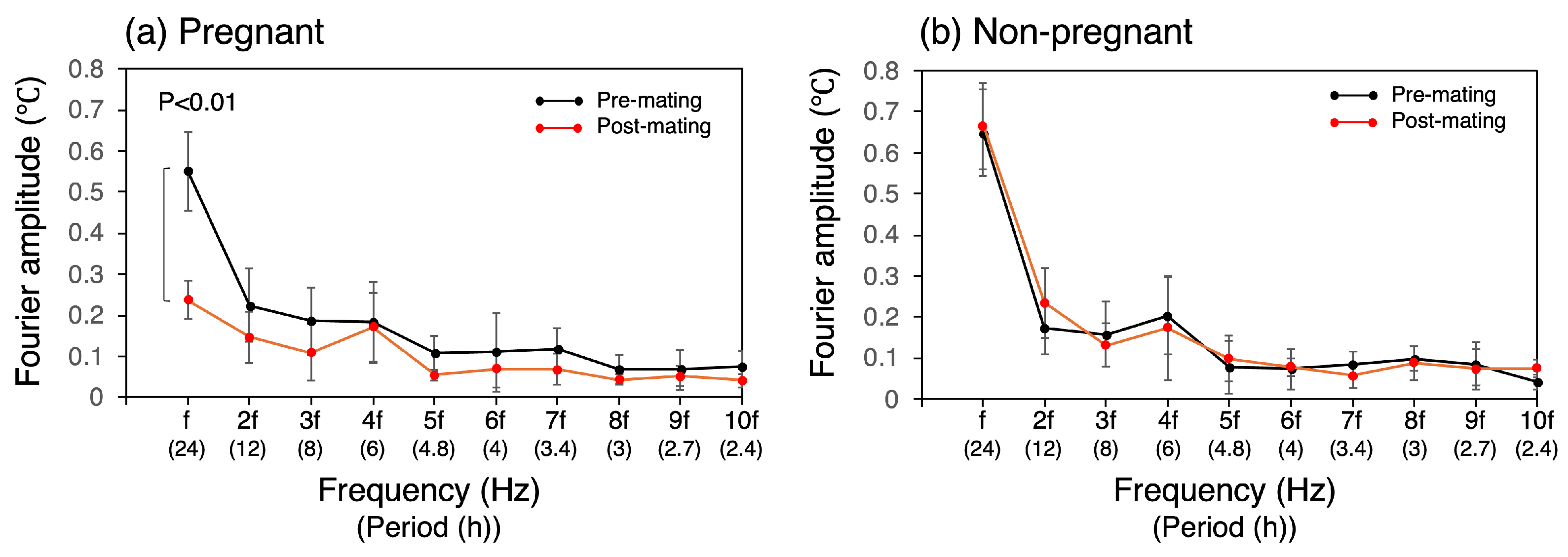Temperature Dynamics in Early Pregnancy: Implications for Improving In Vitro Fertilization Outcomes
Abstract
:1. Introduction
2. Materials and Methods
2.1. Core Body Temperature Data Collection
2.2. Data Analysis
2.2.1. Trend Analysis
2.2.2. Frequency Analysis
2.2.3. Irregular Variation Analysis
2.2.4. Complexity Analysis

2.2.5. Statistics
3. Results
3.1. Core Body Temperature (CBT) Trends
3.2. Fourier Analysis
3.3. Irregular Variation
3.4. Multiscale Entropy (MSE) Analysis
4. Discussion
- The mean CBT for the five days before mating was 37.23 °C in the pregnant group and 37.28 °C in the non-pregnant group, aligning with the standard CBT typically reported in mice. Furthermore, no abnormal behaviors were observed, and none of the mice showed signs of illness, suggesting that implanting the temperature loggers did not negatively impact their well-being.
- The mean CBT of the pregnant mice exhibited a significant increase from 37.23 °C to 37.56 °C, indicating a rise of 0.33 °C. This change was observed over a 10-day period, encompassing the five days prior to mating and the five days following mating.
- Examining the circadian rhythm of CBT, no changes were observed during the dark phase. However, during the light phase, all pregnant mice exhibited an increase in CBT, with a statistically significant average rise of 0.58 °C.
- Consequently, the amplitude of the CBT circadian rhythm decreased from 0.75 °C to 0.27 °C, with mean temperatures of 37.42 °C during the light phase and 37.69 °C during the dark phase.
- The Fourier amplitude spectra analysis revealed that the CBT rhythm had the largest 24 h component, followed by significant 12, 8, and 6 h components. In the pregnant mice, the 24 h component showed the most substantial and statistically significant amplitude decrease of 57%, reducing the amplitude to 0.24 °C. The amplitudes of the 12 and 8 h components were 0.15 °C and 0.11 °C, respectively, while the 6 h component remained unaltered at 0.17 °C.
- All the pregnant mice showed a statistically significant decrease in the variability of the irregular fluctuation component, resulting in a standard deviation of 0.28 °C. However, no such reduced-variability trend was observed in the non-pregnant group.
- In the pregnant mice, the sample entropy increased across all the scales (statistically significant from scale factors 1 to 11), whereas in the non-pregnant mice, no changes in the complexity of CBT variability were observed.
4.1. Temperature Increase Post-Mating
4.2. Circadian Rhythms and Embryo Development
4.3. Fourier Analysis of Temperature Fluctuations
4.4. Variability and Complexity
4.5. Limitations and Future Studies
5. Conclusions
Author Contributions
Funding
Institutional Review Board Statement
Informed Consent Statement
Data Availability Statement
Acknowledgments
Conflicts of Interest
Abbreviations
| IVF | In vitro fertilization |
| ART | Assisted reproductive technology |
| CBT | Core body temperature |
| MSE | Multiscale entropy |
References
- Kagari, Y.; Jwa, S.C.; Kuwahara, A.; Iwasa, T.; On, M.; Kato, K.; Kishi, H.; Kuwabarak, Y.; Taniguchi, F.; Harada, M.; et al. Assisted reproductive technology in Japan: A summary report for 2021 by the Ethics Committee of the Japan Society of Obstetrics and Gynecology. Reprod. Med. Biol. 2024, 23, e12552. [Google Scholar]
- Swain, J.E.; Carrell, D.; Cobo, A.; Meseguer, M.; Rubio, C.; Smith, G.D. Optimizing the culture environment and embryo manipulation to help maintain embryo developmental potential. Fertil. Steril. 2016, 105, 571–587. [Google Scholar] [CrossRef] [PubMed]
- Heo, Y.S.; Cabrera, L.M.; Bormann, C.L.; Smith, G.D.; Takayama, S. Real time culture and analysis of embryo metabolism using a microfluidic device with deformation based actuation. Lab A Chip 2012, 12, 2240–2246. [Google Scholar] [CrossRef]
- Hawkins, J.; Miao, X.; Cui, W.; Sun, Y. Biophysical optimization of preimplantation embryo culture: What mechanics can offer ART. Mol. Hum. Reprod. 2021, 27, gaaa087. [Google Scholar] [CrossRef] [PubMed]
- Liu, J.; Zhou, Y.H.; Wang, X.X.; Tong, L.X.; Li, Y.H.; Liu, L.; Xu, Z.Y.; Wang, H.H. Effects of Different Types of Incubators on Embryo Development and Clinical Outcomes. In Infertility and Assisted Reproduction; IntechOpen: London, UK, 2020. [Google Scholar]
- Bahat, A.; Eisenbach, M.; Tur-Kaspa, I. Periovulatory increase in temperature difference within the rabbit oviduct. Hum. Reprod. 2005, 20, 2118–2121. [Google Scholar] [CrossRef] [PubMed]
- Hunter, R. Temperature gradients in female reproductive tissues. Reprod. Biomed. Online 2012, 24, 377–380. [Google Scholar] [CrossRef] [PubMed]
- Grant, A.; Smarr, B. Feasibility of continuous distal body temperature for passive, early pregnancy detection. PLOS Digit. Health 2022, 1, e0000034. [Google Scholar] [CrossRef]
- Smarr, B.L.; Zucker, I.; Kriegsfeld, L.J. Detection of successful and unsuccessful pregnancies in mice within hours of pairing through frequency analysis of high temporal resolution core body temperature data. PLoS ONE 2016, 11, e0160127. [Google Scholar] [CrossRef]
- Coyne, M.D.; Kesick, C.M.; Doherty, T.J.; Kolka, M.A.; Stephenson, L.A. Circadian rhythm changes in core temperature over the menstrual cycle: Method for noninvasive monitoring. Am. J. Physiol.-Regul. Integr. Comp. Physiol. 2000, 279, R1316–R1320. [Google Scholar] [CrossRef] [PubMed]
- Moriyama, D.F.; Makri, D.; Maalouf, M.N.; Adamova, P.; de Moraes, G.F.A.; Pinheiro, M.d.O.; Bernardineli, D.L.; Massaia, I.F.D.S.; Maalouf, W.E.; Lo Turco, E.G. The effects of temperature variation treatments on embryonic development: A mouse study. Sci. Rep. 2022, 12, 2489. [Google Scholar] [CrossRef]
- Neelke, D.M.; Ronny, J.; Samuel, S.R.; Herman, T.; de Velde Hilde, V.; Greta, V. The effect of different temperature conditions on human embryosin vitro: Two sibling studies. Reprod. BioMed. Online 2019, 38, 508–515. [Google Scholar] [CrossRef]
- Hara, T.; Matsuura, K.; Kodama, T.; Sato, K.; Kikkawa, Y.; Muneto, T.; Tanaka, J.; Naruse, K. A tilting embryo culture system increases the number of high-grade human blastocysts with high implantation competence. Reprod. BioMed. Online 2013, 26, 260–268. [Google Scholar] [CrossRef] [PubMed]
- Heo, Y.; Cabrera, L.; Bormann, C.; Shah, C.; Takayama, S.; Smith, G. Dynamic microfunnel culture enhances mouse embryo development and pregnancy rates. Hum. Reprod. 2010, 25, 613–622. [Google Scholar] [CrossRef] [PubMed]
- Hickman, D.L.; Beebe, D.J.; Rodriguez-Zas, S.L.; Wheeler, M.B. Comparison of static and dynamic medium environments for culturing of pre-implantation mouse embryos. Comp. Med. 2002, 52, 122–126. [Google Scholar]
- Matsuura, K.; Hayashi, N.; Kuroda, Y.; Takiue, C.; Hirata, R.; Takenami, M.; Aoi, Y.; Yoshioka, N.; Habara, T.; Mukaida, T.; et al. Improved development of mouse and human embryos using a tilting embryo culture system. Reprod. Biomed. Online 2010, 20, 358–364. [Google Scholar] [CrossRef]
- West, E.R.; Xu, M.; Woodruff, T.K.; Shea, L.D. Physical properties of alginate hydrogels and their effects on in vitro follicle development. Biomaterials 2007, 28, 4439–4448. [Google Scholar] [CrossRef] [PubMed]
- Gamo, Y.; Bernard, A.; Mitchell, S.E.; Hambly, C.; Al Jothery, A.; Vaanholt, L.M.; Król, E.; Speakman, J.R. Limits to sustained energy intake. XVI. Body temperature and physical activity of female mice during pregnancy. J. Exp. Biol. 2013, 216, 2328–2338. [Google Scholar] [CrossRef] [PubMed]
- Wharfe, M.D.; Wyrwoll, C.S.; Waddell, B.J.; Mark, P.J. Pregnancy suppresses the daily rhythmicity of core body temperature and adipose metabolic gene expression in the mouse. Endocrinology 2016, 157, 3320–3331. [Google Scholar] [CrossRef]
- Humeau-Heurtier, A. The multiscale entropy algorithm and its variants: A review. Entropy 2015, 17, 3110–3123. [Google Scholar] [CrossRef]
- Costa, M.; Goldberger, A.L.; Peng, C.K. Multiscale entropy analysis of complex physiologic time series. Phys. Rev. Lett. 2002, 89, 068102. [Google Scholar] [CrossRef]
- Costa, M.; Goldberger, A.L.; Peng, C.K. Multiscale entropy analysis of biological signals. Phys. Rev. E—Stat. Nonlinear Soft Matter Phys. 2005, 71, 021906. [Google Scholar] [CrossRef]
- Varela, M.; Calvo, M.; Chana, M.; Gomez-Mestre, I.; Asensio, R.; Galdos, P. Clinical implications of temperature curve complexity in critically ill patients. Crit. Care Med. 2005, 33, 2764–2771. [Google Scholar] [CrossRef] [PubMed]
- Varela, M.; Churruca, J.; Gonzalez, A.; Martin, A.; Ode, J.; Galdos, P. Temperature curve complexity predicts survival in critically ill patients. Am. J. Respir. Crit. Care Med. 2006, 174, 290–298. [Google Scholar] [CrossRef] [PubMed]
- Varela, M.; Jimenez, L.; Fariña, R. Complexity analysis of the temperature curve: New information from body temperature. Eur. J. Appl. Physiol. 2003, 89, 230–237. [Google Scholar] [CrossRef] [PubMed]
- Chaffin, C.L.; VandeVoort, C.A. Follicle growth, ovulation, and luteal formation in primates and rodents: A comparative perspective. Exp. Biol. Med. 2013, 238, 539–548. [Google Scholar] [CrossRef]
- Walters, E.A.; Brown, J.L.; Krisher, R.; Voelkel, S.; Swain, J.E. Impact of a controlled culture temperature gradient on mouse embryo development and morphokinetics. Reprod. BioMed. Online 2020, 40, 494–499. [Google Scholar] [CrossRef] [PubMed]
- Hong, K.H.; Lee, H.; Forman, E.J.; Upham, K.M.; Scott, R.T., Jr. Examining the temperature of embryo culture in in vitro fertilization: A randomized controlled trial comparing traditional core temperature (37 °C) to a more physiologic, cooler temperature (36 °C)✩. Fertil. Steril. 2014, 102, 767–773. [Google Scholar] [CrossRef] [PubMed]
- Grant, A.D.; Newman, M.; Kriegsfeld, L.J. Ultradian rhythms in heart rate variability and distal body temperature anticipate onset of the luteinizing hormone surge. Sci. Rep. 2020, 10, 20378. [Google Scholar] [CrossRef]
- Grant, A.D.; Wilsterman, K.; Smarr, B.L.; Kriegsfeld, L.J. Evidence for a coupled oscillator model of endocrine ultradian rhythms. J. Biol. Rhythm. 2018, 33, 475–496. [Google Scholar] [CrossRef]
- Rostaghi, M.; Azami, H. Dispersion entropy: A measure for time-series analysis. IEEE Signal Process. Lett. 2016, 23, 610–614. [Google Scholar] [CrossRef]
- Rhea, C.K.; Silver, T.A.; Hong, S.L.; Ryu, J.H.; Studenka, B.E.; Hughes, C.M.; Haddad, J.M. Noise and complexity in human postural control: Interpreting the different estimations of entropy. PLoS ONE 2011, 6, e17696. [Google Scholar] [CrossRef] [PubMed]
- García-Martínez, S.; Latorre, R.; Sánchez-Hurtado, M.; Sánchez-Margallo, F.; Bernabò, N.; Romar, R.; López-Albors, O.; Coy, P. Mimicking the temperature gradient between the sow’s oviduct and uterus improves in vitro embryo culture output. Mol. Hum. Reprod. 2020, 26, 748–759. [Google Scholar] [CrossRef] [PubMed]
- Geneva, I.I.; Cuzzo, B.; Fazili, T.; Javaid, W. Normal body temperature: A systematic review. Open Forum Infect. Dis. 2019, 6, ofz032. [Google Scholar] [CrossRef] [PubMed]
- Murayama, Y.; Kitazawa, M.; Sato, H.; Uemura, A. The accuracy of abdominal skin temperature in detecting ovulation compared to basal body temperature. Jpn. J. Appl. IT Healthc. 2022, 17, 6–9. [Google Scholar]
- Murayama, Y.; Uemura, A.; Kitazawa, M.; Toyotani, J.; Taniuchi, A.; Togawa, T. Determination of biphasic menstrual cycle based on the fluctuation of abdominal skin temperature during sleep. Adv. Biomed. Eng. 2023, 12, 28–36. [Google Scholar] [CrossRef]






Disclaimer/Publisher’s Note: The statements, opinions and data contained in all publications are solely those of the individual author(s) and contributor(s) and not of MDPI and/or the editor(s). MDPI and/or the editor(s) disclaim responsibility for any injury to people or property resulting from any ideas, methods, instructions or products referred to in the content. |
© 2024 by the authors. Licensee MDPI, Basel, Switzerland. This article is an open access article distributed under the terms and conditions of the Creative Commons Attribution (CC BY) license (https://creativecommons.org/licenses/by/4.0/).
Share and Cite
Murayama, Y.; Abe, T.; Tang, Z. Temperature Dynamics in Early Pregnancy: Implications for Improving In Vitro Fertilization Outcomes. Appl. Sci. 2024, 14, 7392. https://doi.org/10.3390/app14167392
Murayama Y, Abe T, Tang Z. Temperature Dynamics in Early Pregnancy: Implications for Improving In Vitro Fertilization Outcomes. Applied Sciences. 2024; 14(16):7392. https://doi.org/10.3390/app14167392
Chicago/Turabian StyleMurayama, Yoshinobu, Tomoki Abe, and Zunyi Tang. 2024. "Temperature Dynamics in Early Pregnancy: Implications for Improving In Vitro Fertilization Outcomes" Applied Sciences 14, no. 16: 7392. https://doi.org/10.3390/app14167392
APA StyleMurayama, Y., Abe, T., & Tang, Z. (2024). Temperature Dynamics in Early Pregnancy: Implications for Improving In Vitro Fertilization Outcomes. Applied Sciences, 14(16), 7392. https://doi.org/10.3390/app14167392







